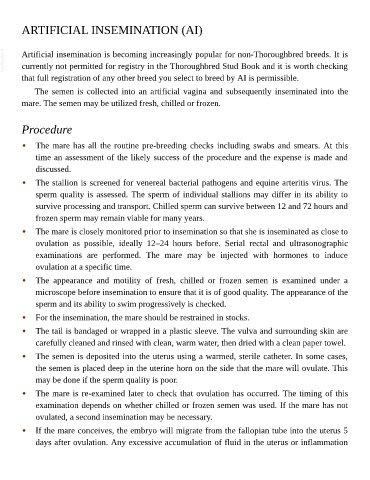Page 935 - The Veterinary Care of the Horse
P. 935
ARTIFICIAL INSEMINATION (AI)
VetBooks.ir Artificial insemination is becoming increasingly popular for non-Thoroughbred breeds. It is
currently not permitted for registry in the Thoroughbred Stud Book and it is worth checking
that full registration of any other breed you select to breed by AI is permissible.
The semen is collected into an artificial vagina and subsequently inseminated into the
mare. The semen may be utilized fresh, chilled or frozen.
Procedure
• The mare has all the routine pre-breeding checks including swabs and smears. At this
time an assessment of the likely success of the procedure and the expense is made and
discussed.
• The stallion is screened for venereal bacterial pathogens and equine arteritis virus. The
sperm quality is assessed. The sperm of individual stallions may differ in its ability to
survive processing and transport. Chilled sperm can survive between 12 and 72 hours and
frozen sperm may remain viable for many years.
• The mare is closely monitored prior to insemination so that she is inseminated as close to
ovulation as possible, ideally 12–24 hours before. Serial rectal and ultrasonographic
examinations are performed. The mare may be injected with hormones to induce
ovulation at a specific time.
• The appearance and motility of fresh, chilled or frozen semen is examined under a
microscope before insemination to ensure that it is of good quality. The appearance of the
sperm and its ability to swim progressively is checked.
• For the insemination, the mare should be restrained in stocks.
• The tail is bandaged or wrapped in a plastic sleeve. The vulva and surrounding skin are
carefully cleaned and rinsed with clean, warm water, then dried with a clean paper towel.
• The semen is deposited into the uterus using a warmed, sterile catheter. In some cases,
the semen is placed deep in the uterine horn on the side that the mare will ovulate. This
may be done if the sperm quality is poor.
• The mare is re-examined later to check that ovulation has occurred. The timing of this
examination depends on whether chilled or frozen semen was used. If the mare has not
ovulated, a second insemination may be necessary.
• If the mare conceives, the embryo will migrate from the fallopian tube into the uterus 5
days after ovulation. Any excessive accumulation of fluid in the uterus or inflammation

